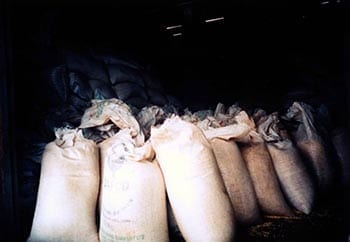
A type of fungus coating much of the stored corn, wheat, rice and nuts in developing countries may be quietly worsening the AIDS epidemic, according to a paper published today in the World Mycotoxin Journal.
Kept in sacks piled in barns and warehouses, food stores in countries near the equator are contaminated by Aspergillus flavus and A. parasiticus, fungi that produce a toxic substance called aflatoxin. About 4.5 billion people worldwide are exposed to aflatoxin at unsafe levels, and chronic exposure has been linked to liver damage and related cancers; but its role in the spread of infectious disease could make it even more deadly.
“Our work suggests study that aflatoxin exposure may be taking an even greater toll in areas where millions are infected with HIV, including Africa and Asia, the latter with a fast-growing HIV population and rice storage areas contaminated by fungi,” said Pauline, Jolly, Ph.D., professor in the Department of Epidemiology within the School of Public Health at the University of Alabama at Birmingham (UAB). Strict regulation and monitoring minimize exposure in the United States.
Jolly and her colleagues recruited 314 HIV-positive people who were not yet on antiretroviral therapy for the study in Kumasi, Ghana. They divided patients into four groups based on their level of aflatoxin exposure and found that those in the highest exposure group were 2.6 times more likely to have a high HIV viral load than those in the lowest exposure group. Higher viral load translates into higher rates of HIV transmission and the potential for earlier progression to the opportunistic infections of AIDS.
“Previous studies by our team had looked at the possible interaction of aflatoxin and HIV on immune suppression, and this study examined twice as many patients as previous studies,” said Jolly, the study’s corresponding author. “It also was structured to eliminate factors such as opportunistic infections and antiviral combination therapy in clarifying the relationship between aflatoxin exposure and HIV for the first time.”
Leading theories suggest that the fungal toxin may suppress the immune system by reducing the production of certain immune cells or the proteins that activate them. The toxin also may increase the expression of genes that result in more copies of the virus, but more study is needed to confirm the mechanisms.
The Latest Bing News on:
Aflatoxin
- IAR Releases 17 New Crop Varietieson April 27, 2024 at 4:10 am
The Institute of Agricultural Research, IAR/ABU, has introduced 17 new crop varieties to the existing collection to better serve farmers' requirements.Prof. Ado Adamu Yusuf, IAR executive director, ...
- Govt orders ethylene oxide testing for spice export to Hong Kong, Singaporeon April 24, 2024 at 9:26 pm
Currently, spice exports to Singapore and Hong Kong require mandatory testing for the carcinogen Aflatoxin and the dye Sudan I-IV ...
- Aflatoxin, Tobacco, Ammonia and the p53 Tumor-Suppressor Gene: Cancer's Missing Link?on April 22, 2024 at 4:59 pm
Aflatoxin, the fungal carcinogen first identified in 1960, is now recognized as the prototypical laboratory carcinogen. It causes mutations in the p53 tumor-suppressor gene as well as ras ...
- Genvor to Unveil Latest Research on Patented Peptides for Aflatoxin Resistance in Corn at BioAgTech World Congresson April 22, 2024 at 5:31 am
Chad Pawlak, Chief Executive Officer of Genvor, commented: "Aflatoxin contamination is a significant issue facing American corn farmers, presenting a critical threat to both human and livestock health ...
- Happy & Polly Debuts All-Natural, Healthy Cat Litter Alternative in Honor of Earth Dayon April 17, 2024 at 3:10 am
It is free from aflatoxin, formaldehyde, artificial colors, and harmful bacteria. The litter’s dust-free formula not only promotes a healthier environment, but also reduces the risk of infections. It ...
- Millers raise alarm over high aflatoxin in Ugandan maizeon April 9, 2024 at 12:28 am
Millers have raised concern over the high level of aflatoxin contamination, especially in maize being sold at the border point of Busia. The millers said cheap maize coming into the market from ...
- Peanut Butter Recall: More products recalled amid aflatoxin concernson March 10, 2024 at 2:18 pm
In light of escalating aflatoxin concerns, further recalls of peanut butter products have been initiated, heightening consumer apprehension. The National Consumer Commission (NCC) has taken swift ...
- Kenya can’t regulate its way out of aflatoxin menaceon May 13, 2021 at 2:00 pm
[Kipsang Joseph/Standard] Efforts to control aflatoxin in Kenya mostly focus on testing maize once it reaches our borders, or once it hits supermarket shelves. Enforcement of food safety ...
- Prevalence of aflatoxin understatedon September 19, 2020 at 8:47 pm
Aflatoxin is caused by a host of factors that start from the forthcoming pre-planting phase, to the post-harvest phase. Primarily, lack of crop rotation interferes with soil nutrients and ...
- 10 Tools For Fighting Aflatoxin, Which Causes Liver Cancer And Childhood Stuntingon March 22, 2019 at 3:17 am
Aflatoxin is a type of toxin caused by a fungus (certain kinds of Aspergillus) that occurs naturally in hot and humid climates. It’s a silent killer as it doesn’t change the taste of food ...
The Latest Google Headlines on:
Aflatoxin
[google_news title=”” keyword=”aflatoxin” num_posts=”10″ blurb_length=”0″ show_thumb=”left”]
The Latest Bing News on:
Aflatoxin exposure
- Govt orders ethylene oxide testing for spice export to Hong Kong, Singaporeon April 24, 2024 at 9:26 pm
Currently, spice exports to Singapore and Hong Kong require mandatory testing for the carcinogen Aflatoxin and the dye Sudan I-IV ...
- Aflatoxin, Tobacco, Ammonia and the p53 Tumor-Suppressor Gene: Cancer's Missing Link?on April 22, 2024 at 4:59 pm
often show the same p53 mutations associated with aflatoxin exposure. The role of ammonia in neutralizing aflatoxin contamination is examined, as well as the potential role of the FDA in ...
- Mycotoxin Exposure and Early Life Gut Microbiome Development in Nigerian Neonates and Infantson April 16, 2024 at 5:01 pm
Knowledge gaps persist in our understanding of how mycotoxin exposure influences the development of the gut microbiota (GM) in neonates and infants (NIs). Given the pivotal role of the gut microbiome ...
- Report reveals foods that give you canceron April 6, 2024 at 5:00 pm
“Uganda Cancer Institute receives 170 to 200 liver cancer cases per year (incident cases) and 48 to 56 of the new cases of liver cancer at the institute result from aflatoxin exposure. This ...
- Professional Faqs: We Consume Peanuts Very Often Either Boiled, Roasted, Crushed Or After Making It Into A Paste Form As A Part Of Our Indian Breakfast And Food. Should I Be ...on April 5, 2024 at 8:37 am
You can reduce your aflatoxin exposure by buying only major commercial brands. Food and Drug Administration (FDA) tests foods that may contain aflatoxins, such as peanuts and peanut butter.
- Thyroid Disease Newson April 2, 2024 at 4:59 pm
First Look, January 10, 2023 Sex Differences in HBV-Associated Liver Cancer Liver cancer genetics and biology differ between men and women and help explain why aflatoxin exposure increases the ...
- Hazardous mold contaminates many food staples: What you should know about mycotoxinson March 27, 2024 at 5:01 pm
Exposure can also happen through inhalation ... Ginger has been found to contain aflatoxin and ochratoxin A (which is known to be teratogenic: capable of causing developmental abnormalities ...
- Woolworths and Pick n Pay recall products over high aflatoxin levels. What is aflatoxin and should you be worried?on February 23, 2024 at 6:17 am
What are the side effects? The side effects of aflatoxin exposure are multifaceted and may be severe in the case of overexposure, which have not been the case in neither Pick n Pay nor Woolworths ...
- Specialists warn of rise in aflatoxin poisoning from illicit liquoron February 18, 2023 at 2:39 am
Food specialists are worried of outbreak of aflatoxin poisoning during this season festivities, when many people in urban slums and rural areas are expected to drink plenty of busaa. Consumers of ...
- KEBS: List of unga brands that contain aflatoxinon November 9, 2019 at 6:25 am
These fungi can contaminate crops in the field, during harvest, and even storage. Human exposure to aflatoxins has been associated with an increased risk of liver cancer infection. The World ...
The Latest Google Headlines on:
Aflatoxin exposure
[google_news title=”” keyword=”aflatoxin exposure” num_posts=”10″ blurb_length=”0″ show_thumb=”left”]




